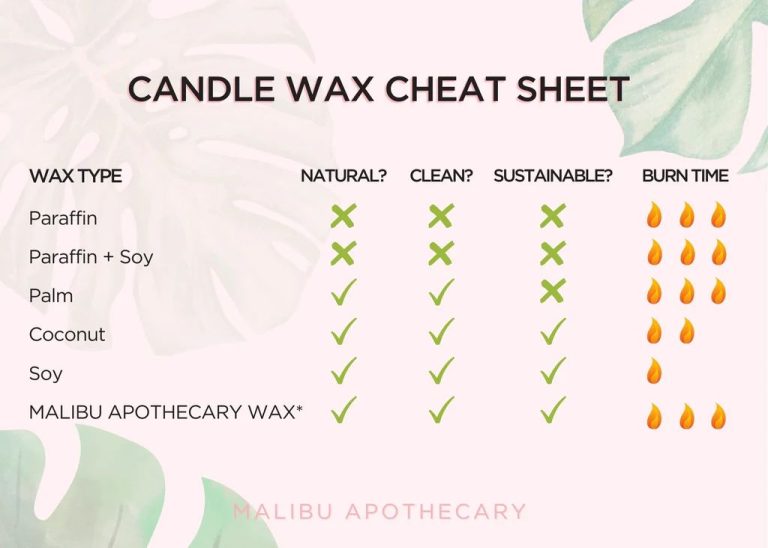What Kind Of Wax Is Dw Home Candles?
DW Home is a popular candle brand known for its wide variety of scented candles. Founded in 2003, the company offers candles in various styles including jars, tumblers, pillars and votives. DW Home aims to create inviting, nostalgic scents using proprietary wax blends and fragrance oils.
While DW Home is best known for its signature scented candles, they also offer candle accessories and home fragrance products like reed diffusers and room sprays. Their extensive candle collection features seasonal scents as well as timeless fragrance favorites. Overall, DW Home strives to provide high-quality, long-lasting candles at affordable prices for candle lovers.
Candle Wax Types
There are several different types of wax that are commonly used to make candles. Here are some of the main candle wax options:
Paraffin Wax
Paraffin wax is a petroleum-based wax made from refining crude oil. It is the most commonly used candle wax due to its low cost and availability. Paraffin wax is highly pliable and can hold fragrance oils well. The drawbacks are that paraffin wax produces more soot as it burns and is not environmentally-friendly.
Soy Wax
Soy wax is made from hydrogenated soybean oil. It is a renewable and sustainable wax made from plants. Soy wax burns cleaner than paraffin with less soot. It is also biodegradable and environmentally-friendly. However, soy wax is more expensive and can lose scent when burning.
Beeswax
Beeswax is a natural wax made by honey bees. It has a sweet honey scent and burns the cleanest of waxes with minimal soot. Beeswax is also biodegradable. The downside is beeswax is expensive and difficult to work with due to its high melting point.
Gel Wax
Gel wax contains mineral oil blended with paraffin or soy wax to create a transparent, rubbery gel consistency. Gel candles burn slower with no dripping. But gel wax can lose fragrance intensity over time and is not eco-friendly.
DW Home’s Signature Scented Wax
DW Home Candles are made from a proprietary blend of waxes designed specifically by their master candle makers to provide an optimal burn and fragrance diffusion. The signature DW Home wax formula contains a blend of high quality paraffin wax, natural soy wax, eco-friendly palm wax, and proprietary polymer additives.
Paraffin wax, derived from petroleum, provides excellent fragrance retention and full wax pool melting. Soy wax, made from soybeans, allows the fragrance to naturally diffuse into the air. Palm wax comes from the fruit of palm trees and gives off very minimal soot. The polymer additives help strengthen the wax structure and improve the burn properties.
By artfully blending these waxes along with DW Home’s masterfully crafted fragrances, the signature DW Home candle wax provides a clean, long lasting burn, excellent fragrance throw, and reduced sooting. The custom wax formulation took years for DW Home’s expert candle makers to perfect through extensive testing and refinement.
The result is a proprietary DW Home candle wax that allows their candles to fill any space with beautiful fragrance, provide 50-55 hours of burn time, and minimize mess or maintenance. It’s what sets DW Home candles apart from competitors and gives them their signature look, feel, and scent.
Paraffin Wax
Paraffin wax is a soft, colorless wax derived from petroleum, coal, or oil shale. It’s composed of hydrocarbons, primarily alkane chains ranging from 20 to 40 carbons long. This gives paraffin wax some key properties that make it desirable for candle making:
- Low melting point – Paraffin melts at around 115-150°F, making it easy to melt and pour into candle vessels.
- Odorless and colorless – Paraffin won’t interfere with candle scents or dyes.
- Burns cleanly – The wax melts and vaporizes completely when burned, leaving no waxy residue.
- Hardens nicely – Paraffin forms a smooth surface and retains the shape of the candle vessel well when cooled.
- Affordable – Paraffin is inexpensive compared to natural waxes.
With its ideal melting point, clean burn, and cost effectiveness, paraffin became the wax of choice for mass-produced candles in the mid-to-late 1800s. It remains the most common candle wax today due to its reliable performance and low price point.
Soy Wax
Soy wax is made from hydrogenated soybean oil. It is composed mostly of hydrogenated soybean oil along with some other vegetable waxes. Soy wax has a lower melting point compared to other waxes, melting between 115-135 degrees Fahrenheit. It is softer and less brittle than paraffin wax.
Soy wax has some advantages for candle making. It is made from a renewable and sustainable crop, soybeans, rather than petroleum like paraffin wax. Soy wax also burns longer and cleaner than paraffin, producing less soot. Since it is softer, soy wax allows for easier release from candle molds and detailed design elements. Soy wax candles require less frequent trimming of the wick as well.
The drawbacks of soy wax include its softness, which can lead to issues like wet spots on the candle surface, frosting, and bending of slender candles. It also does not retain scent as well as paraffin wax. Soy wax has a lower melting point so soy candles are more prone to melting in warm environments. Proper blending with other waxes is required to optimize the burning properties of soy wax in candle making.
Beeswax
Beeswax is a natural wax produced by honey bees. It is secreted from special glands in the bee’s abdomen and used by bees to build the walls of their honeycomb. Beeswax has a naturally sweet, honey-like scent.
The main component of beeswax is myricyl palmitate ester. It also contains other long-chain alcohols, hydroxypolyesters, hydrocarbons, and aromatics. Minor components include fatty acids, long-chain aldehydes, long-chain ethers, terpenes, and vitamins A and E.
Beeswax offers some benefits for candlemaking. It has a low melting point range of 62°C to 64°C, which makes it easy to work with. The natural scent of beeswax gives candles a lovely honey aroma. Beeswax is also renewable and biodegradable.
However, beeswax also has some drawbacks. It can be expensive compared to other waxes. It also burns quicker than harder waxes, so beeswax candles may not last as long. The honey color of beeswax can also discolor added fragrances and dyes. Beeswax is not as transparent when melted compared to paraffin, either.
Gel Wax
Gel wax is a type of candle wax that has a transparent, gel-like appearance. It is made from a blend of mineral oil and polymer resins. Unlike other waxes like paraffin or soy, gel wax has a crystal clear, shiny finish when cooled into a solid state.
The main component of gel wax is mineral oil, which gives it a thick, gelatinous texture. The polymer resins help harden the wax when cooled and also help the wax hold scent and dye. One of the key advantages of gel wax is its ability to hold fragrance oils better than most other waxes.
Gel waxes also have excellent glass adhesion properties, meaning they cling very well to the sides of glass candle containers and vases. This helps maximize fragrance throw and allows gel candles to retain their shape as they burn down. The transparency of gel wax allows candle colors to appear more vivid since the body color of the wax does not dilute the dye.
Compared to paraffin, soy, or beeswax, gel wax has a smoother finish and provides excellent fragrance retention. It is popular for container candles, especially those in clear glass vessels. However, gel wax requires the addition of a hardener for freestanding pillar or votive candles. It also cannot be used for rolled candles, unlike pliable waxes like beeswax. Overall, gel wax produces brilliantly colored, strongly scented candles with a crystal clear appearance.
Blending Waxes
Candle makers often blend different types of waxes together to achieve desirable qualities and customized performance. Blending waxes allows manufacturers to balance properties like melt point, scent throw, surface finish, cost efficiency, and more. Some common reasons for blending candle waxes include:
- Combining the high scent throw of paraffin wax with the natural source and biodegradability of soy wax.
- Mixing the perfect balance of soy, paraffin and palm waxes to optimize burn time, wax appearance and fragrance diffusion.
- Adding just a touch of beeswax to soy or paraffin for its natural honey-like aroma and beautiful natural finish.
Popular blended wax candles include combinations like:
- 70% paraffin wax with 30% soy wax – Good scent throw and clean burn.
- 60% soy wax blended with 40% paraffin – Natural soy with enhanced scent throw.
- 70% palm wax with 30% soy wax – Natural blend with excellent scent throw.
- 80% paraffin blended with 10% soy and 10% beeswax – Great scent diffusion and natural honey notes.
The options for custom blended waxes are nearly endless. Master candle makers experiment with different wax variations to create specialized candles optimized for fragrance, burn, appearance and sustainability.
Fragrance Oils
Fragrance oils are an essential component of scented candles like those made by DW Home. They are what gives the candles their signature scents and allow them to fill a room with a pleasant aroma when lit. DW Home uses high quality fragrance oils that are formulated to be safe for burning in their candles.
DW Home is known for their unique and sophisticated scents. Some of their most popular fragrance oils that can be found across their candle lines include:
- Bergamot & Black Tea – A bright, crisp blend of bergamot and black tea.
- Palo Santo – Warm woody notes meet mystical palo santo and smokey vanilla.
- Sea Salt & Driftwood – A relaxing coastal scent with notes of sea spray, driftwood, seashells, and musk.
- Tobacco & Whiskey – Masculine scent layers tobacco leaf, worn leather, and spiced whiskey.
- Lavender Fog – Calming French lavender blended with hints of vanilla and sandalwood.
The proprietary fragrance blends are what gives each DW Home candle its signature scent that can’t be found anywhere else. Their master perfumers carefully craft each formula not just for scent but also for performance, ensuring they have excellent hot and cold throw when burned.
Conclusion
In conclusion, the type of wax used in DW Home Candles is a proprietary wax blend developed by the company to meet their desired performance and fragrance standards. It is likely a blend of paraffin and natural waxes that allows the candles to burn evenly, hold their shape, and create a smooth wax pool while also providing an excellent medium for fragrance oils.
DW Home has opted to create their own signature scented wax rather than using a single type of wax like soy, beeswax or paraffin. This allows them to customize the qualities of the wax and achieve their desired performance. The wax blend is central to creating DW Home’s signature scented candles that are renowned for their strong scents and clean burns.
While the exact formula is proprietary, it is clear that extensive research, development and testing has gone into creating the ideal wax for DW Home Candles. The blend strikes a balance between an even burn, fragrance delivery and aesthetic appeal. In the end, it is the overall performance, scent strength and quality that matter most to consumers. DW Home seems to have found the right mix with their signature candle wax.




